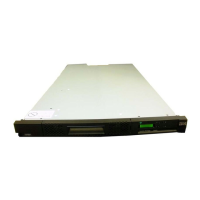[BACK] [ UP ] [DOWN] [ENTER]
An IPv6 (Dual) address combines an IPv6 and an IPv4 address and has the following
format: y : y : y : y : y : y : x . x . x . x. The IPv6 portion of the address
(indicated with y's) is always at the beginning, followed by the IPv4 portion (indicated with
x's).
• In the IPv6 portion of the address, y is called a segment and can be any hexadecimal
value between 0 and FFFF. The segments are separated by colons - not periods. The
IPv6 portion of the address must have six segments but there is a short form notation
for segments that are zero.
• In the IPv4 portion of the address x is called an octet and must be a decimal value
between 0 and 255. The octets are separated by periods. The IPv4 portion of the
address must contain three periods and four octets.
Examples of valid IPv6 (Dual) addresses:
• 2001 : db8: 3333 : 4444 : 5555 : 6666 : 1 . 2 . 3 . 4
• : : 11 . 22 . 33 . 44 (implies all six IPv6 segments are zero)
• 2001 : db8: : 123 . 123 . 123 . 123 (implies that the last four IPv6 segments
are zero)
• : : 1234 : 5678 : 91 . 123 . 4 . 56 (implies that the first four IPv6 segments
are zero)
• : : 1234 : 5678 : 1 . 2 . 3 . 4 (implies that the first four IPv6 segments are
zero)
• 2001 : db8: : 1234 : 5678 : 5 . 6 . 7 . 8 (implies that the middle two IPv6
segments are zero)
• Subnet masks (IPv4) and prefix lengths (IPv6)
This topic defines subnet masks and prefixes.
Parent topic: IPv6 functionality
Subnet masks (IPv4) and prefix lengths (IPv6)
This topic defines subnet masks and prefixes.

